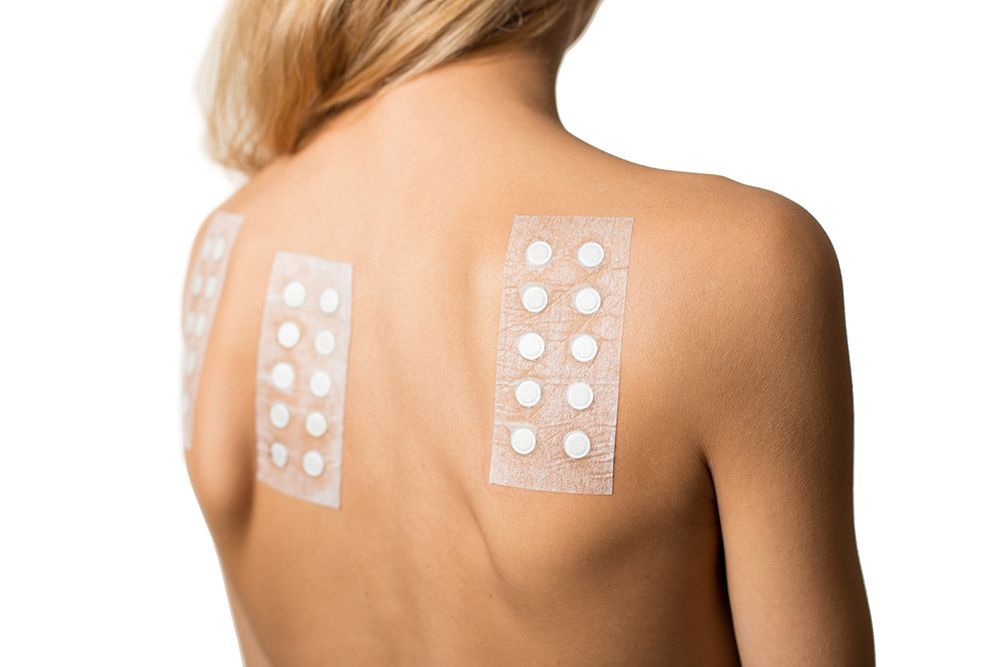
Patch Test
The patch test is the basic test used in the diagnosis of allergic contact dermatitis (AKD). It gives very valuable results when evaluated by considering the history and physical examination findings.
Application
A patch test unit (adhesive tape containing chambers [“Finn chamber”, “IQ chamber”, etc.]) is used.
Test materials (allergens at standard concentrations in the appropriate base) are carefully placed inside the shallow chambers in the test units, starting from the upper right corner.
If ready-to-use tapes (such as “T.R.U.E. test”) are to be applied, the standard envelope is opened and the ready-made test material is adhered directly to the skin.
The test material is adhered to the back area.
If the patient's skin is (very) oily, the test area is gently cleaned with ethanol before the procedure.
After the application, the perimeter of the test material is marked and the chambers are numbered.
The patient is warned not to get the test area wet (bathing, sweating, excessive physical activity, etc.) and not to engage in activities that may cause the tapes to come off.
After 48 hours, the test material is removed, the test area is marked with a pencil and evaluated after 30 minutes. The test site is reassessed at 72 or 96 hours. Evaluation at 48 hours alone is not sufficient. Second and third evaluations should be made at 72 or 96 hours in order to detect late reactions. In fact, since late reactions may develop after one week, especially to neomycin and topical corticosteroids, the test areas should be re-evaluated at the end of the first week, based on the patient's anamnesis and clinical findings, and the back should not be washed during this period.
The information and consent form is read and signed by each patient.
One week before the test, topical corticosteroids applied to the back should be discontinued, and care should be taken that the patient is not using systemic corticosteroids or immunosuppressants.
No UV treatment should have been applied to the application site in the last three weeks.
The test should be avoided in acute eczema exacerbations.
It would be appropriate not to do patch testing in pregnant women.
If the tapes cannot be applied to the back, they can also be applied to the upper outer parts of the arms.
In a few cases of hypersensitivity to some allergens, severe itching, burning and erythema may develop very rarely, starting a few hours after the application of the patch test. In such cases, if the patient cannot contact with the doctor, it is recommended to remove the test materials.
When removing the bands, their location should be marked with a marker. Taking a close-up digital photo(s) of the back after the test (at 48th, 72nd and 96th hours) is a very easy and useful method today in terms of better evaluation of the results.
Para-phenylenediamine, topical corticosteroids, neomycin and gold may react at 96 hours. If necessary, the test site should be reassessed after one week, as noted above.
Contact allergy to aluminum is extremely rare. The presence of annular-appearing positive reactions in all areas in patch tests using the “Finn chamber” should bring this to mind. The problem is solved by the use of metal-free materials.
Care should be taken when performing patch testing with materials brought by the patient and suspected to be the cause of ACD, and patch testing should not be performed with products of unknown content or industrial materials with a high potential for irritation. To minimize the possibility of severe irritation, open testing (repeated open application) is recommended first. Preparations that can be applied to the skin (such as cosmetic products) are applied to the forearm area in the morning and evening for a week. Especially when patch testing is planned with products such as shampoo and liquid soap that need to be removed from the skin, it is important to dilute the products at a concentration of at least 0.01% and to increase the concentration later if necessary.
After the application of non-standardized products, there is a possibility of development of contact urticaria.
Very rarely, contact urticaria can develop with standard materials. Therefore, patients should be kept waiting for about 20 minutes after patch test application and those with itching should be evaluated in terms of contact urticaria.
